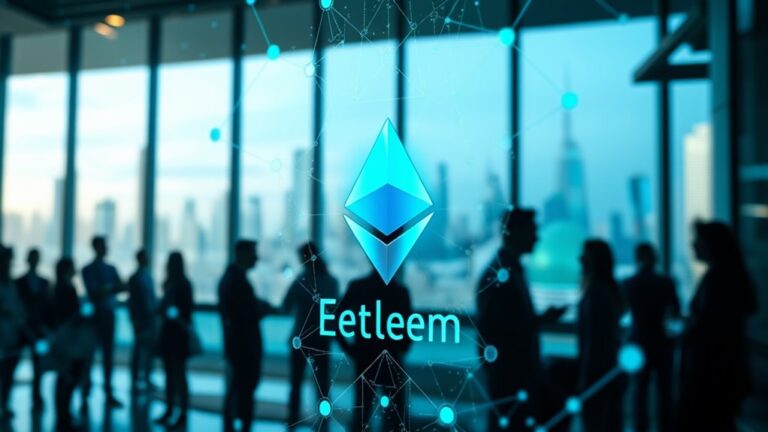
Ethereum DeFi Ecosystem: A Beginner’s Guide to Decentralized Finance
Ethereum’s DeFi ecosystem offers decentralized financial services through blockchain technology. Built on smart contracts, these self-executing agreements enable lending, trading, and yield farming without traditional intermediaries. Users interact with DeFi applications using specialized wallets like MetaMask, accessing decentralized exchanges and liquidity pools to earn passive income. While offering financial inclusion and innovation, participants should understand security risks including smart contract vulnerabilities and impermanent loss. The expanding ecosystem continues to evolve with layer-2 scaling solutions and cross-chain capabilities.
Key Takeaways
- DeFi utilizes Ethereum’s smart contracts to create trustless financial services without intermediaries like banks or brokers.
- Users can participate in lending, borrowing, trading, and yield farming through interconnected protocols while maintaining control of assets.
- MetaMask and similar wallets serve as essential gateways for interacting with DeFi applications on Ethereum.
- Yield strategies include liquidity provision, staking, and lending, each offering rewards while helping secure the ecosystem.
- Understanding risks like smart contract vulnerabilities and impermanent loss is crucial before committing assets to DeFi protocols.
Understanding the Foundation of Ethereum Blockchain

While many people view cryptocurrencies as merely digital money, Ethereum stands apart as an extensive blockchain platform with far-reaching applications beyond simple transactions. Launched in 2015 by essential Vitalik Buterin and other key founders, Ethereum operates on a decentralized model, allowing anyone to access and use its platform without centralized control.
At its core, Ethereum relies on blockchain technology—a distributed ledger storing transactions across numerous computers. The platform’s native cryptocurrency, Ether (ETH), serves both as a payment method and reward for network validators.
What truly distinguishes Ethereum is its programmability through the Ethereum Virtual Machine (EVM), a runtime environment where smart contracts execute. This functionality enables developers to create decentralized applications that run autonomously on the blockchain, extending Ethereum’s utility far beyond basic financial exchanges. Furthermore, Ethereum’s transition to proof-of-stake has significantly improved its efficiency and sustainability.
Navigating Smart Contracts and Their Role in DeFi

Smart contracts form the backbone of Ethereum’s DeFi ecosystem, enabling automated trustless transactions without intermediaries while maintaining security through immutable code.
These self-executing agreements follow preset conditions to facilitate lending, trading, and yield farming across various DeFi protocols with transparent execution visible on the blockchain.
Understanding the architecture of DeFi protocols requires recognizing how smart contracts interact with each other, creating interconnected financial services that operate according to predetermined rules coded for specific financial functions. Additionally, the use of decentralized applications enhances user accessibility and engagement within the DeFi landscape.
Smart Contract Safety Basics
At the core of DeFi operations lies a critical system of automated protocols whose vulnerabilities can lead to catastrophic financial losses.
Smart contracts, despite their revolutionary potential, remain susceptible to coding flaws, reentrancy attacks, and logic errors that hackers actively exploit.
Security best practices include thorough auditing by reputable firms, which helps detect vulnerabilities and optimize code efficiency before deployment.
Bug bounty programs encourage community participation in identifying weaknesses, while formal verification provides mathematical assurance of contract correctness.
Users should remain vigilant about centralized components within DeFi platforms, particularly oracles that feed external data into smart contracts.
The interconnected nature of protocols creates additional risk, as vulnerabilities in one contract can cascade through dependent systems.
Continuous monitoring and updates remain essential for maintaining security in this evolving ecosystem. Furthermore, smart contract vulnerabilities can lead to unauthorized access and significant financial losses if not adequately addressed.
Automated Trustless Transactions
How did decentralized finance revolutionize traditional financial systems? At its core, the transformation stems from smart contracts—self-executing agreements with coded terms that operate without intermediaries.
These autonomous protocols enable trustless transactions where parties can interact directly, secured by blockchain technology rather than third-party institutions.
Smart contracts function as programmable building blocks in DeFi, orchestrating complex financial services from lending platforms like Aave to decentralized exchanges such as Uniswap. Their power lies in conditional execution: when predefined conditions are met, transactions automatically process, enhancing efficiency while reducing costs.
This trustless architecture delivers several advantages: increased security through decentralization, greater accessibility regardless of location, improved transparency via public ledgers, and significant cost reductions by eliminating middlemen. Furthermore, the rise of leading dApps has further demonstrated the potential of DeFi to disrupt traditional finance.
However, smart contract vulnerabilities remain an ongoing concern requiring thorough security audits.
DeFi Protocol Architecture
The infrastructure of decentralized finance protocols resembles an intricate digital ecosystem built on layers of programmable code. At its core, smart contracts automate financial processes without intermediaries, functioning as the fundamental building blocks of the DeFi landscape.
These protocols typically feature:
- Smart contracts that execute predetermined functions like lending, trading, and yield optimization
- Composability elements allowing different protocols to interact seamlessly, creating complex financial products
- Governance mechanisms empowering token holders to participate in protocol decision-making
- Security measures including regular audits to protect against vulnerabilities
This architecture enables unprecedented financial innovation through its open-source nature. Additionally, the integration of decentralized finance (DeFi) into the broader Ethereum ecosystem enhances the potential for user autonomy and interconnectedness.
Protocols like Uniswap, Aave, and MakerDAO leverage these components to deliver specialized services within the broader Ethereum DeFi ecosystem, demonstrating how modular design facilitates diverse applications.
Essential Crypto Wallets for Your DeFi Journey

Maneuvering the decentralized finance landscape requires robust and secure crypto wallets that serve as gateways to various DeFi protocols and applications.
These wallets allow users to maintain control of their private keys while interacting with decentralized applications.
For Ethereum-based DeFi participation, MetaMask and Coinbase Wallet provide reliable options with strong dApp integration.
Beginners might prefer user-friendly interfaces offered by Plus Wallet or Exodus, which support multiple blockchains and simplify asset management.
Security remains paramount when selecting a wallet, with features like two-factor authentication, encryption, and hardware wallet compatibility offering enhanced protection.
Advanced users benefit from wallets that include built-in staking options, token swapping across chains, and gas fee optimization to reduce transaction costs on congested networks. Additionally, understanding Ethereum wallets is essential for ensuring secure transactions and effective asset management within the DeFi ecosystem.
Exploring Decentralized Exchanges (DEXs)

With secure wallets in place, users can now explore the trading environment of decentralized exchanges (DEXs), which form the backbone of Ethereum’s DeFi ecosystem.
These peer-to-peer marketplaces operate through smart contracts, allowing direct cryptocurrency trading without intermediaries while users maintain custody of their funds.
DEXs offer several key advantages over traditional exchanges:
Decentralized exchanges empower users with greater control, broader access, improved privacy, and censorship resistance.
- Enhanced security through reduced counterparty risk, as assets remain in user control
- Access to a diverse range of tokens not available on centralized platforms
- Financial inclusion without requiring personal information or identity verification
- Resistance to censorship due to their decentralized architecture
While various DEX models exist, including automated market makers (AMMs) like Uniswap and order book systems, users should be aware of potential smart contract vulnerabilities and fluctuating transaction fees. Additionally, understanding trading pairs is essential for successful trading on these platforms.
Yield Farming and Liquidity Pools Explained

Yield farming represents a key DeFi investment strategy where users deposit assets into liquidity pools to earn rewards in the form of transaction fees and governance tokens.
These liquidity pools, managed by smart contracts and priced through automated market makers, enable traders to swap tokens without traditional order books while generating returns for liquidity providers.
Despite the potential for high yields, participants must carefully navigate risks like impermanent loss, which occurs when asset prices shift considerably after deposit, potentially offsetting or eliminating earned rewards. Additionally, the transition to Ethereum 2.0 aims to enhance security and scalability, which could further benefit the DeFi ecosystem.
DeFi Yield Strategies
The pursuit of passive income in the Ethereum ecosystem has led to the development of sophisticated DeFi yield strategies that have revolutionized how investors interact with digital assets.
These strategies primarily involve staking or lending cryptocurrencies to generate rewards while providing essential liquidity to decentralized platforms.
Yield farming approaches vary in complexity and risk profiles:
- Liquidity pools – Users deposit token pairs into pools, earning transaction fees proportional to their contribution.
- Staking – Locking tokens to secure blockchain networks while earning rewards.
- Recursive lending – Leveraging borrowed assets multiple times to maximize yields.
- Cross-chain farming – Diversifying yield opportunities across multiple blockchain networks.
While these strategies can provide significant returns, they also carry risks including market volatility, smart contract vulnerabilities, and potential regulatory changes. Additionally, engaging in these yield strategies allows participants to utilize their assets without selling them, offering unique advantages in the realm of crypto lending.
Impermanent Loss Risks
Among the chief considerations for DeFi participants, impermanent loss represents one of the most misunderstood yet significant risks in liquidity provision. This phenomenon occurs when asset values change after deposit in liquidity pools, potentially decreasing the value of the initial investment compared to simply holding those assets.
The constant product formula used by platforms like Uniswap contributes to this risk, especially during high market volatility. Liquidity providers may offset these potential losses through trading fees and reward tokens from yield farming activities. Additionally, similar to how Ethereum staking allows users to earn rewards, liquidity providers can benefit from the passive income generated through trading fees and yield farming rewards.
Several mitigation strategies exist, including selecting pools with correlated assets (like stablecoin pairs), using specialized platforms such as Curve Finance, or diversifying across multiple pools. Some protocols, including Bancor V2, even offer impermanent loss insurance to protect providers against these risks.
Pool Rewards Maximization
Maximizing returns within the DeFi ecosystem requires understanding the interrelated mechanisms of yield farming and liquidity pools.
By strategically positioning assets across various protocols, users can optimize their earning potential while providing essential liquidity to decentralized exchanges.
Effective pool rewards maximization typically involves:
- Compounding rewards by reinvesting earned tokens into higher-yielding opportunities
- Diversifying liquidity provision across multiple platforms to balance risk and reward
- Utilizing governance tokens to access additional yield-generating opportunities
- Leveraging DeFi aggregators that automatically route funds to the most profitable pools
This approach creates a more efficient market while offering participants markedly higher returns than traditional finance.
However, users should remain mindful of impermanent loss risks and smart contract vulnerabilities when implementing these strategies.
The Power of Stablecoins in DeFi

As cryptocurrency markets continue to experience significant volatility, stablecoins have emerged as essential components of the Ethereum DeFi ecosystem, providing much-needed stability and reliability for users. These digital assets maintain value by pegging to fiat currencies like the US Dollar through various mechanisms of collateralization.
| Stablecoin Type | Examples | Backing Mechanism |
|---|---|---|
| Fiat-Collateralized | USDT, USDC | Direct fiat reserves |
| Crypto-Collateralized | DAI | Cryptocurrency reserves |
| Algorithmic | USDD | Supply adjustments |
Stablecoins serve multiple functions within DeFi, including liquidity provision for decentralized exchanges, yield generation opportunities through lending protocols, and risk management during market downturns. Their cross-platform compatibility enhances interoperability across the ecosystem, while also increasing financial inclusion by providing banking-like services to underserved populations worldwide.
Lending and Borrowing on Ethereum Platforms

The lending and borrowing infrastructure on Ethereum represents one of DeFi’s most fundamental use cases, enabling users to participate in financial markets without traditional intermediaries.
Through platforms like Aave, Compound, and TrueFi, users can lend their crypto assets to earn interest or borrow against collateral.
These lending systems operate through four primary mechanisms:
- Smart contracts that automate loan terms, interest payments, and collateral management
- Over-collateralization requirements that protect lenders from default risks
- Dynamic interest rates determined by supply and demand market forces
- Risk management protocols that monitor collateral values against market volatility
Both centralized and decentralized options exist, with DeFi lending offering greater transparency and peer-to-peer capabilities, while centralized platforms provide structured support and often fixed rates.
Mitigating Risks and Security Best Practices

Security fundamentals form the backbone of Ethereum’s DeFi ecosystem, where complex financial operations demand robust protective measures against potential threats.
Regular third-party audits are essential for identifying vulnerabilities in smart contracts before exploitation occurs, combining automated scanning with manual code reviews.
Developers must adhere to secure coding standards, implementing checks-effects-interactions patterns to prevent reentrancy attacks and using formal verification to validate contract behavior.
Multi-layer security approaches, including multi-signature wallets and transaction monitoring, provide additional protection.
Users play a critical role in maintaining security by employing hardware wallets, enabling two-factor authentication, and staying educated about phishing scams.
Understanding smart contract permissions and keeping wallet software updated further enhances the safety of funds in the DeFi environment.
Future Trends Shaping Ethereum’s DeFi Landscape

Emerging technologies continue to revolutionize Ethereum’s decentralized finance ecosystem, with several key innovations poised to transform how users interact with financial services.
Layer 2 scaling solutions address Ethereum’s transaction bottlenecks by processing activities off-chain, greatly reducing fees and improving performance.
The DeFi landscape is evolving through:
- Cross-chain interoperability bridges enabling seamless asset transfers between different blockchains
- AI integration for enhanced risk management and predictive analytics in DeFi investments
- Financial inclusion initiatives providing services to traditionally underserved populations
- NFT and synthetic asset protocols expanding the range of assets available for collateralization and investment
These advancements collectively support a more accessible, efficient, and diverse DeFi ecosystem built on Ethereum’s foundation.
Frequently Asked Questions
How Do I Calculate and Report Defi Taxes?
Calculating DeFi taxes requires tracking transactions, determining cost basis using FIFO or Specific ID methods, and categorizing events as capital gains or ordinary income. Reporting typically occurs on Form 1040 Schedule 1 and Schedule D.
Can I Participate in Defi With Minimal Funds?
Like a small boat entering the vast ocean, participation in DeFi is possible with minimal funds. Many protocols have low entry requirements, though gas fees on certain networks may impact profitability for smaller investments.
How Does Defi Impact Traditional Banking Systems?
DeFi challenges traditional banking by offering faster transactions, lower costs, and greater accessibility. This disruption forces banks to innovate, potentially losing market share while simultaneously exploring partnerships with decentralized platforms to remain competitive.
What Regulatory Frameworks Apply to Defi Investments?
Like Odysseus charting uncharted waters, DeFi operates in regulatory limbo. Currently, it faces varied securities laws, AML/KYC requirements, and tax regulations across jurisdictions, with frameworks still evolving to address its unique challenges.
How Do I Recover Funds From Failed Transactions?
Recovering funds from failed transactions depends on the cause. Users can attempt increasing gas fees for stuck transactions, use transaction management tools, or contact wallet providers for assistance. Funds sent to incorrect addresses are rarely recoverable.
Conclusion
Ethereum’s DeFi ecosystem represents a revolutionary approach to financial services, offering accessibility without traditional intermediaries. While critics point to volatility risks, these concerns are increasingly addressed through improved security protocols and stablecoin integration. As the space matures, users who educate themselves on best practices can navigate DeFi’s potential while minimizing exposure to common pitfalls, positioning themselves at the forefront of this financial evolution.












